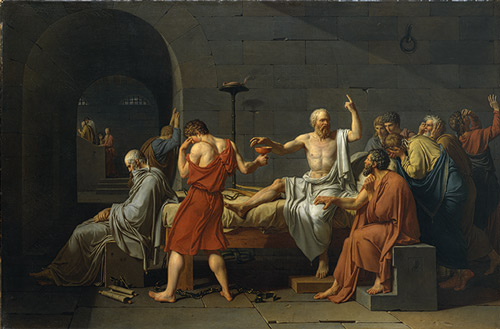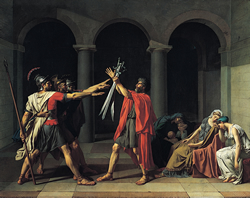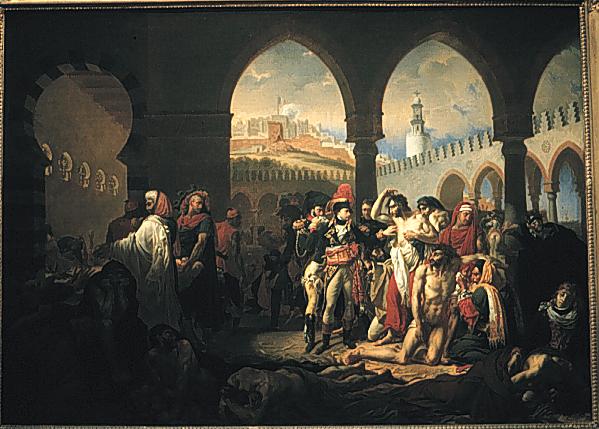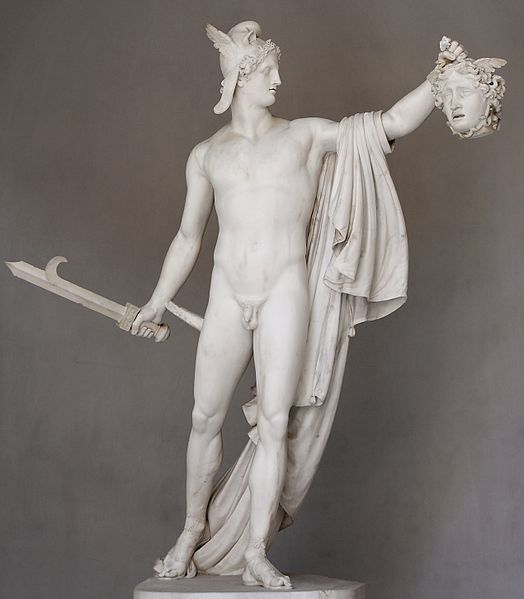
 David- Death of Socrates
David- Death of Socrates David- Oath of the Horatii
David- Oath of the Horatii
Neoclassical Art is a severe and unemotional form of art harkening back to the grandeur of ancient Greece and Rome. Its rigidity was a reaction to the overbred Rococo style and the emotional charged Baroque style. The rise of Neoclassical Art was part of a general revival of interest in classical thought, which was of some importance in the American and French revolutions.
Important Neoclassicists include the architects Robert Smirke and Robert Adam, the sculptors Antonio Canova,Jean-Antoine Houdon and Bertel Thorvaldsen, and painters J.A.D. Ingres, Jacques-Louis David and Anton Raphael Mengs.
Neoclassical Art was also a primary influence on 19th-century Academic ArtWhat any "neo-classicism" depends on most fundamentally is a consensus about a body of work that has achieved canonic status (illustration, below). These are the "classics." Ideally—and neoclassicism is essentially an art of an ideal—an artist, well schooled and comfortably familiar with the canon, does not repeat it in lifeless reproductions, but synthesizes the tradition anew in each work. This sets a high standard, clearly; but though a neoclassical artist who fails to achieve it may create works that are inane, vacuous or even mediocre, gaffes of taste and failures of craftsmanship are not commonly neoclassical failings. Novelty, improvisation, self-expression, and blinding inspiration are not neoclassical virtues. "Make it new" was the modernist credo of the poet Ezra Pound; contrarily, neoclassicism does not seek to re-create art forms from the ground up with each new project. It instead exhibits perfect control of an idiom.
Speaking and thinking in English, "neoclassicism" in each art implies a particular canon of "classic" models - Virgil, Raphael, Nicolas Poussin, Haydn. Other cultures have other canons of classics, however, and a recurring strain of neoclassicism appears to be a natural expression of a culture at a certain moment in its career, a culture that is highly self-aware, that is also confident of its own high mainstream tradition, but at the same time feels the need to regain something that has slipped away: Apollonius of Rhodes is a neoclassic writer; Ming ceramics pay homage to Song-era celadon Chinese porcelains; Italian 15th century humanists learn to write a "Roman" hand we call italic (based on the Carolingian); Neo-Babylonian culture is a neoclassical revival, and in Persia the "classic" religion of Zoroaster, Zoroastrianism, is revived after centuries, to "re-Persianize" a culture that had fallen away from its own classic Achaemenean past. Within the direct Western tradition, the earliest movement motivated by a neoclassical inspiration is a Roman style that was first distinguished by the German art historian Friedrich Hauser (Die Neuattische Reliefs Stuttgart 1889), who identified the style-category he called "Neo-Attic" among sculpture produced in later Hellenistic circles during the last century or so BCE and in Imperial Rome; the corpus that Hauser called "Neo-Attic" consists of bas reliefs molded on decorative vessels and plaques, employing a figural and drapery style that looked for its canon of "classic" models to late 5th and early 4th century Athens and Attica.
visual arts
 Poussin-Abduction of the Sabine Women
Poussin-Abduction of the Sabine Women Jean Gros- Napoleaon Visiting the Plague Victims at Jaffa
Jean Gros- Napoleaon Visiting the Plague Victims at Jaffa
In the visual arts the European movement called "neoclassicism" began after 1765, as a reaction against both the surviving Baroque and Rococo styles, and as a desire to return to the perceived "purity" of the arts of Rome, the more vague perception ("ideal") of Ancient Greek arts, and, to a lesser extent, 16th century Renaissance Classicism.
Contrasting with the Baroque and the Rococo, Neo-classical paintings are devoid of pastel colors and haziness; instead, they have sharp colors with Chiaroscuro. In the case of Neo-classicism in France, a prime example is Jacques Louis David whose paintings often use Roman and Greek elements to extol the French Revolution's virtues (state before family).
Each "neo"- classicism selects some models among the range of possible classics that are available to it, and ignores others. The neoclassical writers and talkers, patrons and collectors, artists and sculptors of 1765–1830 paid homage to an idea of the generation of Pheidias, but the sculpture examples they actually embraced were more likely to be Roman copies of Hellenistic sculptures. They ignored both Archaic Greek art and the works of Late Antiquity. The Rococo art of ancient Palmyra came as a revelation, through engravings in Wood's The Ruins of Palmyra. Even Greece was all-but-unvisited, a rough backwater of the Ottoman Empire, dangerous to explore, so neoclassicists' appreciation of Greek architecture was mediated through drawings and engravings, which subtly smoothed and regularized, "corrected' and "restored" the monuments of Greece, not always consciously. As for painting, Greek painting was utterly lost: neoclassicist painters imaginatively revived it, partly through bas-relief friezes, mosaics, and pottery painting and partly through the examples of painting and decoration of the High Renaissance of Raphael's generation, frescos in Nero's Domus Aurea, Pompeii and Herculaneum and through renewed admiration of Nicholas Poussin. Much "neoclassical" painting is more classicizing in subject matter than in anything else.
There is an anti-Rococo strain that can be detected in some European architecture of the earlier 18th century, most vividly represented in the Palladian architecture of Georgian Britain and Ireland, but also recognizable in a classicizing vein of architecture in Berlin. It is a robust architecture of self-restraint, academically selective now of "the best" Roman models.
Neoclassicism first gained influence in England and France, through a generation of French art students trained in Rome and influenced by the writings of Johann Joachim Winckelmann, and it was quickly adopted by progressive circles in Sweden. At first, classicizing decor was grafted onto familiar European forms, as in the interiors for Catherine II's lover Count Orlov, designed by an Italian architect with a team of Italian stuccadori: only the isolated oval medallions like cameos and the bas-relief overdoors hint of neoclassicism; the furnishings are fully Italian Rococo (illustration, left).
 Canova- Perseus Holding the Head of Medusa
Canova- Perseus Holding the Head of Medusa
But a second neoclassic wave, more severe, more studied (through the medium of engravings) and more consciously archaeological, is associated with the height of the Napoleonic Empire. In France, the first phase of neoclassicism is expressed in the "Louis XVI style", the second phase in the styles we call "Directoire" or Empire. Italy clung to Rococo until the Napoleonic regimes brought the new archaeological classicism, which was embraced as a political statement by young, progressive, urban Italians with republican leanings.
The high tide of neoclassicism in painting is exemplified in early paintings by Jacques-Louis David and Jean Auguste Dominique Ingres' entire career. David's Oath of the Horatii was painted in Rome and made a splash at the Paris Salon of 1785. Its central perspective is perpendicular to the picture plane, made more emphatic by the dim arcade behind, against which the heroic figures are disposed as in a frieze, with a hint of the artificial lighting and staging of opera, and the classical coloring of Nicholas Poussin. In sculpture, the most familiar representatives are the Italian Antonio Canova, the Englishman John Flaxman and the Dane Bertel Thorvaldsen. The European neoclassical manner also took hold in the United States, where its prominence peaked somewhat later and is exemplified in the sculptures of William Henry Rinehart (1825–1874).
